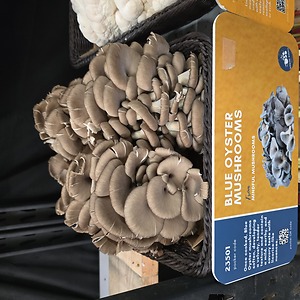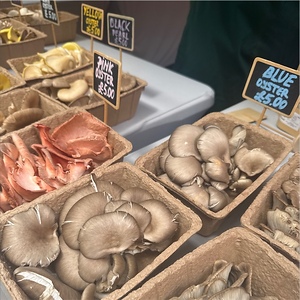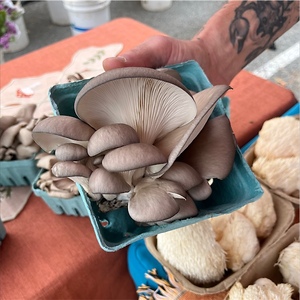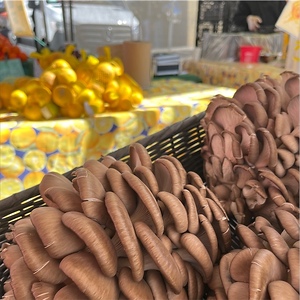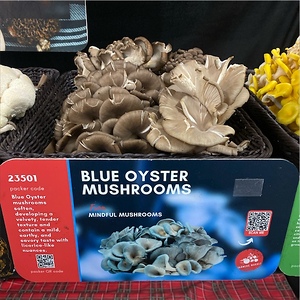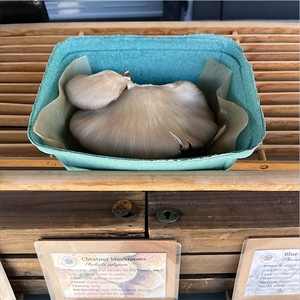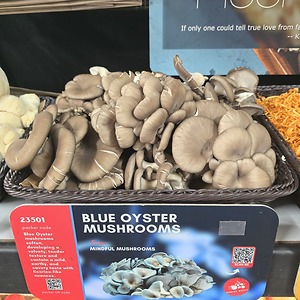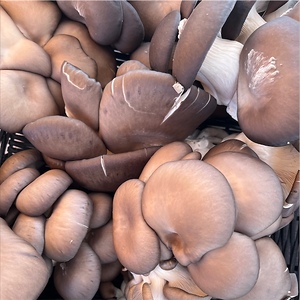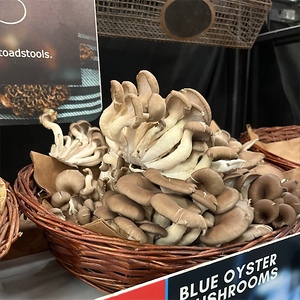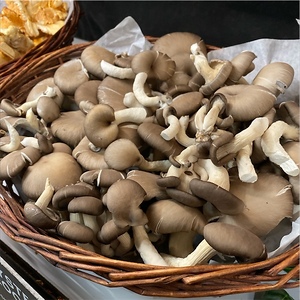

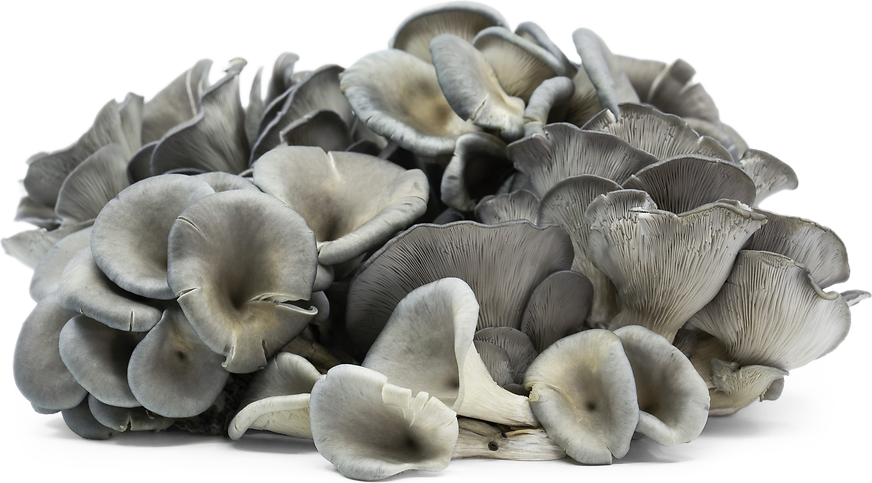
Blue Oyster Mushrooms
Estimated Inventory, lb : 0
Description/Taste
Blue Oyster mushrooms grow in large, shelf-life structures comprised of dense, overlapping clusters of individual fungi. The size and shape of the mushrooms will widely vary, depending on growing conditions and factors like humidity, CO2 levels, and sunlight. Blue Oyster mushrooms can have short, tapered stems with a flat, convex cap, averaging 2 to 30 centimeters in diameter, or the stems can be elongated with smaller caps. The surface of the mushroom’s cap is smooth, taut, and brittle, sometimes containing a slight depression in the center and displaying wavy edges. The caps also appear dark blue when young, lightening into a blue-grey shade with maturity. Underneath the cap, there are slender and vertical, white gills that extend down the stem. The mushroom’s gills contain a high spore content that will eventually be released into the air. Blue Oyster mushrooms have a spongy, dense, and slightly chewy consistency. When raw, the mushrooms bear a scent reminiscent of the seashore combined with anise and have a subtly metallic flavor. Once cooked, Blue Oyster mushrooms soften, developing a velvety, tender texture and contain a mild, earthy, and savory taste with licorice-like nuances.
Seasons/Availability
Blue Oyster mushrooms are available in the spring and fall.
Current Facts
Blue Oyster mushrooms, botanically classified as Pleurotus ostreatus var. columbinus, are a type of shelf fungus belonging to the Pleurotaceae family. Experts believe over two hundred different subspecies of oyster mushrooms exist, and the flat-capped fungi are considered one of the most cultivated mushrooms in the world. Blue Oyster mushrooms are primarily found in the northern hemisphere, growing in large, overlapping clusters on logs, stumps, and decaying trees. The mushrooms have an aggressive nature, are fast-growing, and distinct from other oyster mushrooms as they are able to withstand colder cultivation temperatures. Commercially, Blue Oyster mushrooms are favored by mushroom growers for their unusual coloring, easy-to-grow nature, and fast colonization. The subspecies is also frequently sold through online retailers for home cultivation for novice growers.
Nutritional Value
Blue Oyster mushrooms are a good source of vitamin D to balance phosphate and calcium levels in the body to strengthen bones and teeth. The mushrooms are also a source of B vitamins to increase energy, potassium to regulate fluid levels, vitamin A to maintain optimal organ functioning, and other amounts of iron, copper, and riboflavin. In addition to vitamins and minerals, Blue Oyster mushrooms contain chitin, a polymer that promotes healthy digestive bacteria and antioxidant properties to reduce oxidative stress.
Applications
Blue Oyster mushrooms have a mild, savory flavor well suited for cooked preparations, including braising, sautéing, roasting, frying, grilling, and sir-frying. The mushrooms can be consumed raw, but the flavor may contain a slightly more metallic taste. Blue Oyster mushrooms are most commonly combined with other mushrooms and sauteed to create an earthy and textural side dish, or they are tossed into soups to contribute umami flavors into the broth. The mushrooms are also roasted and stirred into pasta, cooked into omelets, breaded and fried, prepared as a vegetarian substitute for seafood, used as a topping over pizza, grilled and layered onto burgers, or served as a simple side dish. In addition to fresh preparations, Blue Oyster mushrooms can also be dried for extended use and do not have to be rehydrated before using. Blue Oyster mushrooms pair well with herbs such as parsley, thyme, and sage, potatoes, aromatics including garlic, green onion, shallots, ginger, and lemongrass, leeks, asparagus, bok choy, bell pepper, miso, heavy cream, fish, and meats such a beef, poultry, and turkey. The mushrooms will keep up to three days when stored loosely in a brown paper bag in the refrigerator. It is advisable to keep the mushrooms in larger clumps for better storage to keep them from drying out. Once cooked, Blue Oyster mushrooms will keep for 2 to 3 days in the refrigerator, or they can be frozen for up to three months. Blue Oyster mushrooms can also be dried and kept in a sealed container away from direct sunlight for extended use.
Ethnic/Cultural Info
In Japan, Blue Oyster mushrooms are popularly cooked in donabe pots, a traditional Japanese earthenware. The name donabe translates from Japanese to mean “clay pot,” and the handmade cookware was designed for everyday cooking. Donabe pots were developed in Japan's Iga province, and the pots were created to withstand being heated over an open flame or gas burner. Once heated, the pots also retain their heat well, keeping their contents warm for long periods of time. Donabe pots are a staple cookware in Japanese households, and they are still popularly utilized for group meals in the modern day. The pots are most popularly used for nabemono, a style of hot pot, primarily to cook soups and stews during the fall and winter seasons. Donabe pots can be filled with many different ingredients, including Blue Oyster mushrooms, and as the soups are heated, guests can handpick ingredients out of the pot to consume. Oyster mushrooms are also known as hiratake in Japan, and Blue Oyster mushrooms are valued for their unusual coloring. The mushrooms are also favored for adding rich flavors to the broth and providing a vegetarian protein source with a seafood-like texture.
Geography/History
Oyster mushrooms are native to temperate and subtropical regions of the northern hemisphere and have been found growing wild in Europe, North America, and Asia. There are many different subspecies of oyster mushrooms found worldwide, and Blue Oyster mushrooms are believed to have been discovered in Europe. The first written record of oyster mushrooms was documented in 1775 by Dutch naturalist Nikolaus Joseph Freiherr von Jacquin. Oyster mushrooms were also commercially cultivated in Germany beginning in the 1940s and were extensively produced during World War I. Blue Oyster mushrooms feed off primarily dead or decaying wood in the wild, especially beech, oak, maple, chestnut, and birch. Blue Oyster mushrooms are also commercially cultivated worldwide and are sold through online retailers. Beyond foraging or home cultivation, Blue Oyster mushrooms are available at farmer’s markets, specialty grocers, online retailers, and select supermarkets.
Recipe Ideas
Recipes that include Blue Oyster Mushrooms. One



